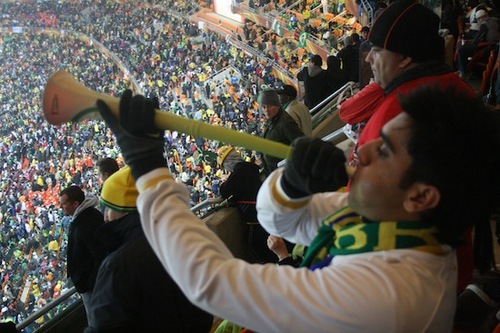Football fans can be divided, somewhat crudely, into two categories: those attracted to the game for aesthetic gratification, and those whose fandom is rather driven by feelings of group solidarity. These categories are not mutually exclusive. A beautiful move acquires even greater beauty when performed by a player or team with whom one identifies; feelings of solidarity are emboldened when joined to rare artistry.
In my own life as a football supporter, my principal affinity is to the London club Arsenal. I am drawn to the club’s commitment, in recent times, to playing attractive passing soccer, and to the cosmopolitan makeup and bearing of the team. But the depth of my identification is more the result of a year spent living in the North London neighborhood where Arsenal plays. On match days, I could hear the undulating cadence of the crowd from my front stoop. In the pub, I hugged random strangers after important goals.
My relationship to the football played in the World Cup is more detached, and more fluid. I hope, above all, for transcendent moments of skill or invention, and for drama. In synch with local sentiment, I have rooted for this World Cup, the first held in Africa, for an African team to advance far into the tournament. Ghana’s “Black Stars” made it to the quarterfinals–becoming the third African side to reach that stage of the competition–before falling, in emotionally devastating fashion, on penalties to Uruguay. Asamoah Gyan, the team’s star striker, acknowledged last week that Ghana carried the expectations of a continent: “We have made everybody proud, not only Ghana, but the whole of Africa.” Where I watched Ghana’s final match, at a bar in the Melville neighborhood of Johannesburg, the DJ began his post-match set with a brief Bob Marley medley–“No Woman, No Cry” transitioning to “Africa Unite”–which nicely captured the evening’s layered mood. And from there the Kwaito party took off.
On 20 June, I visited Johannesburg’s Soccer City stadium to witness Côte d’Ivoire’s encounter with Brazil. My support lay with Côte d’Ivoire, who, though entering the tournament as Africa’s greatest hope for glory, failed to make it out of a difficult group. The crowd inside Soccer City was a motley composition of divided or multiple loyalties–Holland shirts were paired with Brazil hats, Germany scarves with Brazil flags. “O jogo bonito” is universal cultural property; Brazil belongs to the world. The majority of the 85,000 people inside the ground–minus the pockets of mourning Côte d’Ivoire supporters–rejoiced as Elano, Robinho, and Luis Fabiano glided around the field with the ball as their tether.
In Brazil, football as enjoyment and football as identification are inextricably bound. To arouse the nation’s affections, the team must not only win, but do so with style. The current Brazil side and its manager, the ex-player Dunga, have been criticized back home for their un-Brazilian approach. A rigidity of structure and emphasis on defensive discipline, the critique goes, has blunted creative energies both individual and collective–has alienated, in other words, the essence of Brazilian football culture. This critique will only grow louder given Brazil’s early exit from the tournament, after a frankly shambolic performance against Holland in the quarterfinals.
The history of samba-futebol can be traced to the 1930s, when Brazil first brought its radical, playful version of the game to the world stage. “The Brazilians,” Gilberto Freyre observed, “play football as if it is a dance.” In 1958, a young player named Pelé captivated the world’s imagination as Brazil won its first World Cup title. In 1970 Brazil triumphed for a third time, reaching in the process an exalted aesthetic height that remains a footballing ideal.
The universal, Hegel taught, is found in the particular. The football sides that resonate on a planetary, and not just national, scale gesture beyond themselves even as they enact their own singularity. Brazilian football, at its best, is that most precious of things: an expression of national identity that inspires global consciousness. The World Cup is likewise at its best when it occasions such a leap–from identification with the familiar and the past, to identification with the foreign and the yet to come.
Will this World Cup engender such utopian feeling? That depends on where you stand. As yet, despite myriad moments of brilliance, no team or player has conjured anything that might incite global reverence. In any event, we would do well to remember the British historian Tony Mason’s sage, if plaintive, words: “Football may indeed be a passion rather than a pleasure and may be better than nothing but it is certainly not enough.”
Read Eli Jelly-Shapiro’s complete coverage of the World Cup 2010 here:
The World Cup: Will South Africa Shine?
The World Cup II: Bafana Bafana
The World Cup III: In the Stadium’s Shadow
Image: Brazil versus Portugal World Cup Match in Durban, South Africa. Photo by Kwame Nyong’o.


